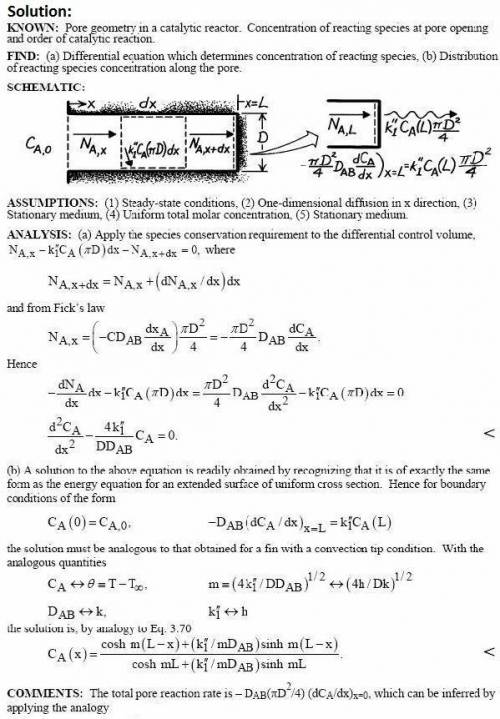
Physics, 11.04.2020 03:07 aredding6282
To enhance the effective surface, and hence the chemical reaction rate, catalytic surfaces often take the form of porous solids. One such solid may be visualized as consisting of a larger number of cylindrical pores, each of diameter D and length L.
Consider conditions involving a gaseous mixture of A and B for which species A is chemically consumed at the catalytic surface. The reaction is known to be first order k1CA. Under steady state, flow over the porous solid is known to maintain a fixed value of the molar concentration CA0 at the pore mouth.
Beginning from fundamentals, obtain the differential equation that governs the variation of CA with distance x along the pore. Applying appropriate boundary conditions, solve the equation to obtain an expression for CA(x).

Answers: 1


Other questions on the subject: Physics

Physics, 21.06.2019 17:30, jazzy2742
Sara is creating an experiment. her hypothesis states the following. if i increase the air in my tires, then i will get better gas mileage. if this is her hypothesis what column titles do we need in our date table? a. air pressure in tire (psi) and gas mileage (mph) b. air pressure in the atmosphere (psi) and gas mileage (mph) c. miles (m) and gallons per mile (g) d. old battery and new battery
Answers: 2

Physics, 21.06.2019 22:30, mirellaenriquez5529
Follow these directions and answer the questions. 1. shine a pencil-thin beam of light on a mirror perpendicular to its surface. (if you don't have a laser light as suggested in the video, you can make a narrow beam from a flashlight by making a cone from black construction paper and taping it over the face of the flashlight.) how does the light reflect? how does the relationship of incident to reflected ray relate to the reflection of water waves moving perpendicular to a barrier? 2. shine a pencil-thin beam of light on a mirror standing on a sheet of paper on the table (or floor) so that you can mark the incident ray and reflected ray. (you can support the mirror from the back by taping it to a wooden block.) 3. mark a line on the paper representing the reflective surface. (the reflective surface of a mirror is usually the back edge.) 4. draw a dashed line perpendicular to the mirror surface at a point where the incident and reflected ray meet. this perpendicular is called a normal to the surface. 5. measure the angles between the rays and the normal. the angle of incidence is the angle formed by the incident ray and the normal to the surface. the angle formed by the reflected ray and normal is called the angle of reflection (r). what is the angle of incidence? what is the angle of reflection? 6. repeat for several different angles. (see report sheet for details.) what appears to be the relationship between the angle of incidence and angle of reflection? in science 1204, what was the relationship for these two angles made by the reflection of waves in a ripple tank? 7. roll a ball bearing so that it hits a fixed, hard surface (a metal plate) at several angles (including head-on). observe the way in which the ball bearing reflects. what generalization can you make about how a ball bearing reflects from a wall? have you proved that light can only behave like a wave?
Answers: 1

Physics, 22.06.2019 05:00, DASASDAEDWEDA
Wavelength, frequency, and energy are related. what happens to a wave as it’s wavelength gets shorter?
Answers: 2

Physics, 22.06.2019 10:00, andresduenas72
Aria drove to the store, did some shopping, and then came home. during maria's trip, when was her displacement equal to zero?
Answers: 1
You know the right answer?
To enhance the effective surface, and hence the chemical reaction rate, catalytic surfaces often tak...
Questions in other subjects:

Mathematics, 16.09.2019 05:10



English, 16.09.2019 05:10

English, 16.09.2019 05:10



Biology, 16.09.2019 05:10

Mathematics, 16.09.2019 05:10





